
Decoding Compensation: Navigating the Landscape of Tourism And Training Consultant Payment Strategies
In the dynamic landscape of destination marketing, the success of a Destination Marketing Organization (DMO) hinges on its ability to engage and educate diverse stakeholders effectively. Crafting impactful training programs is a nuanced endeavor that demands a collaborative effort from qualified professionals with distinct expertise. The collaborative effort of instructional designers, business psychologists, and tourism development experts is not merely a strategic choice but an imperative one for the sustained growth and prosperity of a DMO. In this blog article, we delve into the pivotal role played by these specialists in harmonizing knowledge dissemination, psychological insights, and industry acumen to create comprehensive training initiatives that empower and elevate the myriad stakeholders within the realm of destination marketing. Join us on a journey where the fusion of expertise transcends conventional boundaries, paving the way for a more resilient and informed destination marketing landscape.
Here are three common ways a consultant can structure their contract and payment:
-
Hourly Rate:
- Structure: The consultant charges a fixed rate per hour for their services.
- Advantages: Provides flexibility for both the consultant and the client. It's straightforward and easy to track for short-term projects or when the scope is uncertain.
- Considerations: May not align incentives perfectly, as the consultant may be motivated to spend more hours on the project.
-
Project-Based Fee:
- Structure: The consultant charges a flat fee for the entire project, regardless of the time spent.
- Advantages: Clear expectations on cost for the client, and it incentivizes the consultant to work efficiently.
- Considerations: Requires a well-defined scope of work to avoid scope creep. If the project takes longer than anticipated, the consultant's effective hourly rate could decrease.
-
Retainer Agreement:
- Structure: The client pays a fixed amount regularly (monthly or quarterly) to retain the consultant's services.
- Advantages: Provides a predictable income for the consultant and a sense of security for the client. It's suitable for ongoing or long-term relationships.
- Considerations: The retainer may need to be adjusted based on the evolving needs of the client. The consultant should clearly define the scope of services included in the retainer.
It's crucial to have a well-drafted contract that outlines the terms, scope of work, deliverables, and any other relevant details, regardless of the payment structure chosen. This helps in avoiding misunderstandings and ensures a smooth consulting relationship.
READ ABOUT Custom Course Development and Instructional Design Services
BONUS - Who Are Your Tourism Stakeholders?
Here's an expanded list of stakeholders in tourism, encompassing various people, job titles, job functions, and community members who are intricately connected to the tourism industry:
-
Local Residents:
- Job Titles/Functions: Residents, Community Leaders, Neighborhood Associations
- Impact: Quality of life, cultural preservation, community integration
-
Hospitality Industry Professionals:
- Job Titles/Functions: Hotel Managers, Restaurant Owners, Event Planners
- Impact: Service quality, customer experience, local business growth
-
Tour Guides:
- Job Titles/Functions: Tour Guides, Cultural Ambassadors
- Impact: Visitor experience, cultural exchange, historical interpretation
-
Environmental Conservationists:
- Job Titles/Functions: Conservationists, Environmental Scientists
- Impact: Sustainable tourism practices, wildlife preservation
-
Cultural and Heritage Experts:
- Job Titles/Functions: Curators, Historians, Cultural Preservationists
- Impact: Preservation of heritage sites, cultural education
-
Entrepreneurs:
- Job Titles/Functions: Business Owners, Entrepreneurs
- Impact: Economic development, innovation, job creation
-
Tourism Marketing Professionals:
- Job Titles/Functions: Marketing Managers, Destination Marketers
- Impact: Promotion of tourism, attracting visitors
-
Transportation Professionals:
- Job Titles/Functions: Transportation Planners, Drivers, Pilots
- Impact: Accessibility, transportation infrastructure, connectivity
-
Government Officials:
- Job Titles/Functions: Local and Regional Government Officials
- Impact: Policy-making, regulation, destination development
-
Educators:
- Job Titles/Functions: Tourism Educators, Trainers
- Impact: Skill development, education, knowledge dissemination
-
Artisans and Craftsmen:
- Job Titles/Functions: Local Artisans, Craftsmen
- Impact: Cultural representation, economic contribution
-
Healthcare Professionals:
- Job Titles/Functions: Healthcare Providers, Emergency Responders
- Impact: Public health, safety, medical services for tourists
-
Technology Experts:
- Job Titles/Functions: IT Professionals, Tech Innovators
- Impact: Technological advancements in tourism, digital experiences
-
NGO Representatives:
- Job Titles/Functions: Nonprofit Organizations, Social Workers
- Impact: Social and community development, responsible tourism
-
Local Artists and Performers:
- Job Titles/Functions: Musicians, Artists, Performers
- Impact: Cultural enrichment, entertainment for tourists
-
Law Enforcement:
- Job Titles/Functions: Police Officers, Security Personnel
- Impact: Safety and security of tourists and communities
This comprehensive list illustrates the diverse network of individuals and groups whose roles interconnect to shape the multifaceted impact of tourism on both local and global levels. Read More


Leave a comment